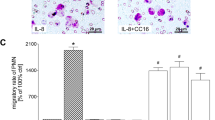Abstract
Objective: To investigate the alternations of surface antigens of leukocytes after severe injury and the correlation with clinical outcome.
Setting: Emergency Department and Intensive Care Unit of a university hospital.
Patients: Patients with severe trauma (injury severity score >16) were enrolled. Those who were transferred or had critical injuries were excluded.
Measurements and results: Polymorphonuclear cells (PMN) and mononuclear cells (MN) were isolated from patients on the 1st, 3rd and 7th day following injury. The mean fluorescent expressions of CD lib and CD16 of PMN, and CD25 of MN were measured and compared with those obtained from paralleled controls. Sixteen injured patients were included. The CD11b expressions of PMN increased on the 1st day and were still high on the 7th day. The CD16 expressions decreased on the 1st day and CD25 decreased on the 3rd day; both were still low on the 7th day. Six patients developed infectious complications. CDllb expression remained high and CD 16 expression remained low on three measurements of the infectious patients, whereas both expressions recovered on the last measurement of non-infectious patients. CD25 expression remained low in both groups. Three infectious patients with pneumonia died from mutiple organ failure.
Conclusion: Phenotypic alternations of leukocytes develop early after severe injury. The alternations may represent a state of activation of PMN and subsequent suppression of IL-2 related immunity. Persistent activation of PMN with enhanced CDllb and attenuated CD16 expression indicates the development of infectious complications and a poor prognosis can be anticipated if the infectious sites can not be controlled early.
Similar content being viewed by others
Explore related subjects
Discover the latest articles and news from researchers in related subjects, suggested using machine learning.References
Grogan JB, Miller RC (1973) Impaired function of polymorphonuclear leukocytes in patients with burns and other trauma. Surg Gynecol Obstet 137: 784–788
Alexander JW, Ogle CK, Stinnett JD, MacMillan BG (1978) A sequential, prospective analysis of immunological abnormalities and infection following severe thermal injury. Ann Surg 188: 809–816
Maderazo EG, Albano SD, Wornick CL, Drezner AD, Quercia R (1983) Polymorphonuclear leukocyte migration abnormalities and their significance in severely traumatized patients. Ann Surg 198: 736–742
Arnaut MA (1990) Structure and function of the leukocyte adhesion molecules CD11/CD18. Blood 75: 1037–1050
Van de Winkel JGJ, Anderson CL (1991) Biology of human immunoglobulin G Fe receptors. J Leukoc Biol 49: 511–524
Moore FD, Davis C, Rodrick M, Mannick JA, Fearon DT (1986) Neutrophil activation in thermal injury as assessed by increased expression of complement receptors. N Engl J Med 314: 948–953
Wood JJ, Rodrick ML, O’Mahony JB, Palder SB, Saporoschetz I, d’Eon P, Mannick JA (1984) Inadequate inter-leukin-2 production: a fundamental immunological deficiency in patients with major burns. Ann Surg 200: 311–320
Greenspan L, Mclellan BA, Greig H (1985) Abbreviated injury scale and injury severity score: A score chart. J Trauma 25: 60–64
Garner JS, Jarvis WR, Emori TG, Horan TC, Hughes JM (1988) CDC definitions for nosocomial infections, 1988. Am J Infect Control 16: 128–140
Ferrante A, Thong YH (1980) Optimal conditions for simultaneous purification of mononuclear and polymorphonuclear leukocytes from human blood by the hypaque-ficoll method. J Immunol Methods 36: 109–117
Ravetch J, Perussia B (1989) Alternation membrane forms of FcrR III (CD 16) on human NK cells and neutrophils. J Exp Med 170: 481–497
Huizinga TW, Haas M, Kleijer M, Nuijens JH, Root D, Von dem Borne AEGKr (1990) Soluble Fcr receptors III in human plasma originates from release by neutrophils. J Clin Invest 86: 416–423
Huizinga TW, Schoot CE, Jose C, Klaassen R, Kleijer M, Borne Albert EGK, Doos D, Tetteroo PAT (1988) The Pi-linked receptor FcrR III is released on stimulation of neutrophils. Nature 333: 667–669
Bich-Thuy LT, Samarut C, Brochier J, Revillard JP (1981) Suppression of the late stages of mitogen-induced human B-cell differentiation by Fcr receptors released from polymorphonuclear neutrophils. J Immunol 127: 1299–1303
Daeron M, Fridman WH (1985) Fc receptors as regulatory molecules. Ann Inst Pasteur Immunol 136c: 383–437
Vindenes H, Bjerknes R (1994) Activation of polymorphonuclear neutrophilic granulocytes following burn injury: alternation of Fc-receptor and complement-receptor expression and of opsonophagocytosis. J Trauma 36: 161–167
Dana N, Todd RF III, Pitt J, Springer T, Arnaout MA (1984) Deficiency of a monocyte-granulocyte surface glycoprotein Mol in man. J Clin Invest 73: 153–159
Smith C, Marlin SD, Rothlein R, Toman C, Anderson D (1989) Cooperative interactions of LFA-1 and Mac-1 with intercellular adhesion molecule-1 in facilitating adherence and transendothelial migration of human neutrophils in vitro. J Clin Invest 83: 2008–2017
Bainton DF, Miller LJ, Kishimoto TK, Springer TA (1987) Leukocyte adhesion receptors are stored in peroxidase-negative granules of human neutrophils. J Exp Med 166:1641–1653
Diener AM, Beatty PG, Ochs HD, Harlan JM (1985) The role of neutrophil membrane glycoprotein 150 (GP 150) in neutrophil mediated endothelial cell injury in vitro. J Immunol 135: 537–543
Simms HH, Amico RD (1991) Increased PMN CD lib/CD 18 expression following post-traumatic ARDS. J Surg Res 50: 362–367
Moore FA, Moore EE (1995) Evolving concepts in the pathogenesis of postinjury multiple organ failure. Surg Clin North Am 75: 257–277
Akiyoshi T, Koba F, Arinaga S, Miyazaki S, Wada T, Tsuji H (1985) Impaired production of interleukin-2 after surgery. Clin Exp Immunol 59: 45–49
Faist E, Schinkel C, Zimmer S, Kremer JP, von Donnersmarck GH, Schildberg FW (1993) Inadequate interleukin-2 synthesis and interleukin-2 messenger expression following thermal and mechanical trauma in humans is caused by defective transmembrane signaling. J Trauma 34: 846–854
Granelli-Piperno A (1988) In situ hybridization of IL-2 and 11-2 receptor mRNA in T cells activated in the presence or absence of cyclosporin A. J Exp Med 168: 1649–1658
Author information
Authors and Affiliations
Additional information
This study was supported by the National Science Council, R. O. C
Rights and permissions
About this article
Cite this article
Shih, H.C., Su, C.H. & Lee, C.H. Alternations of surface antigens on leukocytes after severe injury: correlation with infectious complications. Intensive Care Med 24, 152–156 (1998). https://doi.org/10.1007/s001340050537
Received:
Accepted:
Issue Date:
DOI: https://doi.org/10.1007/s001340050537




